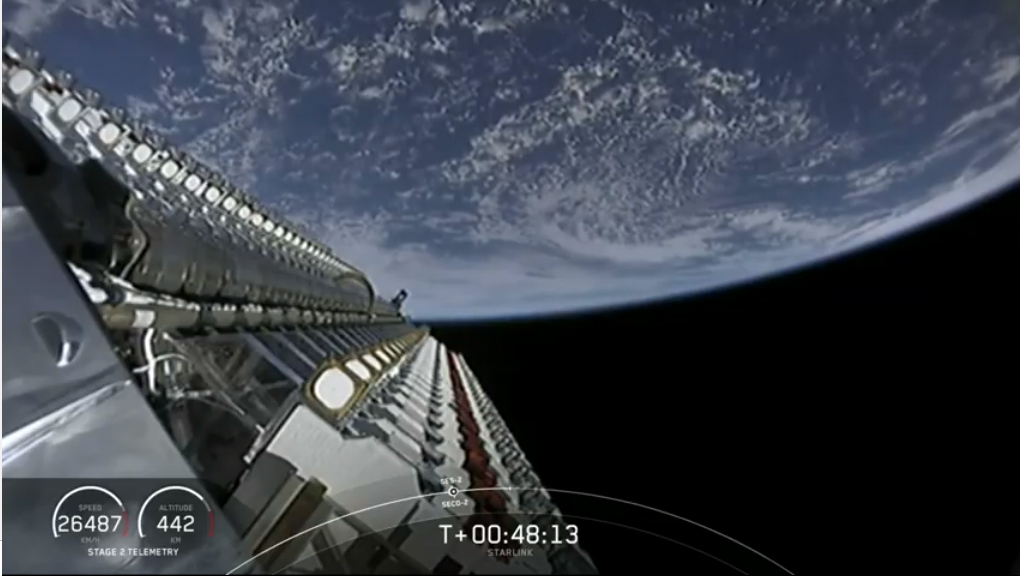The 60 internet satellites SpaceX just launched will be but the tip of a very large off-Earth iceberg, if all goes according to plan.
Last night (May 23), SpaceX lofted the first five dozen members of its Starlink broadband constellation to low-Earth orbit (LEO) using one of the company's workhorse Falcon 9 rockets. Starlink is designed to provide internet connectivity to people around the world, and it will do so using a truly enormous number of satellites.
Starlink won't be able to provide "minor" coverage until about 400 spacecraft are up and running, and "moderate" coverage requires about 800 operational satellites, SpaceX founder and CEO Elon Musk has said. But the company doesn't plan to stop at "moderate."
Related: SpaceX's 1st Starlink Satellite Megaconstellation Launch in Photos!

"In a year and a half, maybe two years, if things go well, SpaceX will probably have more satellites in orbit than all other satellites combined — a majority of the satellites in orbit will be SpaceX," Musk said last week during a prelaunch teleconference with reporters.
That milestone will come around Starlink launch number 30, with 1,800 satellites delivered to orbit, he said.
But the number could rise higher still — much higher, in fact. The Federal Communications Commission has granted SpaceX permission to launch a total of nearly 12,000 Starlink satellites.
Get the Space.com Newsletter
Breaking space news, the latest updates on rocket launches, skywatching events and more!
Musk said SpaceX has taken great pains to ensure the constellation doesn't pose a collision risk to the other denizens of LEO. For example, he said the Starlink satellites can automatically navigate around other spacecraft and larger pieces of orbital debris, using tracking data provided by the North American Aerospace Defense Command (NORAD).
And this first batch is headed for an operational altitude of 340 miles (550 kilometers) — low enough that they'll get pulled down to Earth by atmospheric drag in a few years even if SpaceX doesn't manage to deorbit them intentionally.
"So, I think we've got a really solution for making sure that we do not create orbital debris," he said. "And, worst-case scenario — the good news there is, the atmosphere cleans it up."
SpaceX isn't the only company with eyes on a LEO broadband constellation.
OneWeb, Telesat and Amazon have similar goals, though their networks may not be as big as Starlink. (OneWeb and Telesat envision constellations numbering in the hundreds, and Amazon's Project Kuiper will top out at around 3,200 satellites if all goes according to plan.)
Starlink is a key part of Musk's long-term plan to help humanity colonize Mars. SpaceX hopes to use Starlink revenue to fund the development of Starship and Super Heavy, the spaceship and rocket the company is building to carry people to the Red Planet, Earth's moon and other solar system destinations.
Last night's launch featured a Falcon 9 whose first stage had already flown twice. It launched from Cape Canaveral Air Force Base in Florida, with the booster acing its third-ever landing, touching down on SpaceX's drone ship "Of Course I Still Love You" off the Florida coast.
Each Starlink satellite weighs about 500 lbs. (227 kilograms). Together, the 60 spacecraft made up the heaviest payload that SpaceX has ever launched, Musk said.
- See the Evolution of SpaceX's Rockets in Pictures
- In Photos: SpaceX's 1st Falcon Heavy Rocket Test Launch Success!
- Elon Musk: Private Space Entrepreneur
Mike Wall's book about the search for alien life, "Out There" (Grand Central Publishing, 2018; illustrated by Karl Tate), is out now. Follow him on Twitter @michaeldwall. Follow us on Twitter @Spacedotcom or Facebook.
Join our Space Forums to keep talking space on the latest missions, night sky and more! And if you have a news tip, correction or comment, let us know at: community@space.com.

Michael Wall is a Senior Space Writer with Space.com and joined the team in 2010. He primarily covers exoplanets, spaceflight and military space, but has been known to dabble in the space art beat. His book about the search for alien life, "Out There," was published on Nov. 13, 2018. Before becoming a science writer, Michael worked as a herpetologist and wildlife biologist. He has a Ph.D. in evolutionary biology from the University of Sydney, Australia, a bachelor's degree from the University of Arizona, and a graduate certificate in science writing from the University of California, Santa Cruz. To find out what his latest project is, you can follow Michael on Twitter.









